He was a precursor of the fight for children's rights and the author of books for children. Who was the Old Doctor who, although he could have escaped, went to death with his charges?
His real name was Hersz Goldszmit, although in his youth he used the name Henryk. He was born on July 22, 1878 or 1879 in Warsaw. He came from an assimilated Jewish family. He himself said that he was a Jew and a Pole. He had a difficult childhood - his father, Józef, a well-known Warsaw lawyer, suffered from a mental illness. His multiple hospitalizations and premature death in 1896 put the Goldszmites in financial trouble. Henryk was then forced to work as a tutor to financially support his mother and sister Anna.
Writer, doctor, educator
From an early age, he was interested in literature. He made his debut as a writer in 1896 with the humorous Węzeł gordyjski published in the satirical weekly Kolce. In later years, he wrote articles and reviews for the magazine. He also worked on his first novel - Children of the Street which appeared in 1901. It was then that he started using a literary pseudonym, which later stuck to him for good - Janasz (later Janusz) Korczak.
At the same time, he studied medicine at the Faculty of Medicine at the Imperial University of Warsaw. Already at that time, his commitment to the affairs of the youngest made itself felt. From 1900 he was active in the Summer Camp Society, and later also, inter alia, in the Society of Polish Culture and the Warsaw Hygiene Society. In 1904 and 1907 worked as a tutor for Jewish children in the "Michałówka" holiday center. He was also an educator of Christian children in "Wilhelmówka". Based on the experience of that period, he wrote two books: Mośki, Joski, Srule (1910) and Józki, Jaśki i Franki (1911).
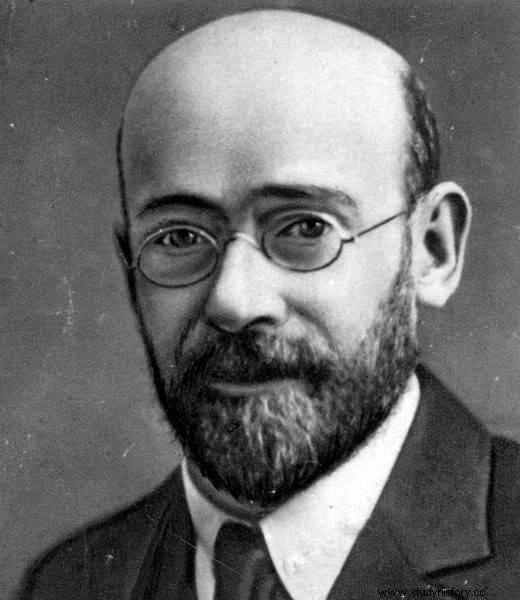
Janusz Korczak
In 1905, he was employed as a local doctor (obliged to provide 24-hour care for patients and work in the hospital infirmary) at the Jewish Hospital for Children. Bersonów and Baumanów in Warsaw. He also served as a military medic during the Russo-Japanese War in 1905. He expanded his knowledge of pediatrics and pedagogy in Berlin, Paris and London. While visiting the latter city, decided not to start a family of his own. He decided to devote himself to working with children. As he said:"For my son I chose the idea of serving the child and his cause."
Childless father of hundreds of toddlers
After returning to Poland, in 1912 he became the director of the Orphans' Home for Jewish children. He held this function until the very end - until 1942. His collaborator was there, among others Stefania Wilczyńska. During World War I worked as the junior head of the division hospital in Samsonov's army. During this period, wrote A Child in the Family , the first part of the tetralogy of How to love a child . In 1915 he met Maryna Falska, with whom he later (in 1919) created a model orphanage in Our House in Pruszków . From 1928, the educational institution operated in Warsaw's Bielany.
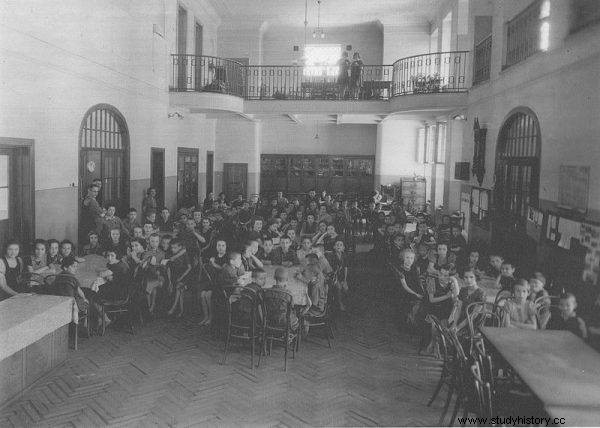
The Orphans' Home on Krochmalna Street in 1940. Soon after, Korczak and his charges were sent to the ghetto.
In all of them, the facility implemented its original educational system. It was based on daily, in-depth observation of the psychophysical development of children. He promoted "self-education" among his charges through partnership, establishing children's self-government institutions (including parliament, court or notary). He kept repeating to his pupils:"We give you a longing for a better life that does not exist and that will be one day."
A precursor of the fight for children's rights
In addition to working as a doctor and tutor in orphanages, he continued to write. Not only books (the most popular ones are Król Maciuś the First , 1923, Bankruptcy of little Dżek , 1924, Kajtuś the wizard , 1934), but also press articles (including for "Kolce", "Czytelnia dla życia", "Głos", "Robotnik" or "Opieka Społeczna").
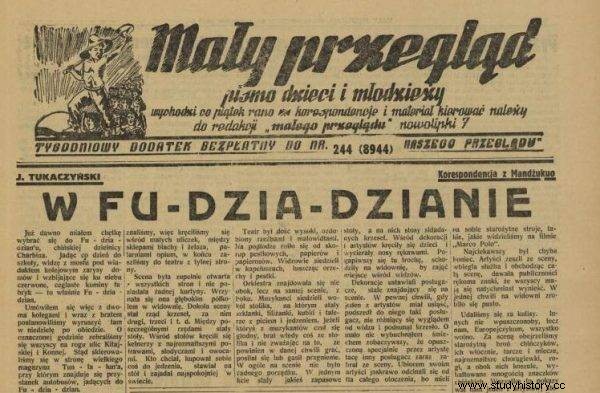
In 1926, Korczak founded an experimental children's newspaper, Mały Przegląd.
In 1926, founded the experimental children's newspaper "Mały Przegląd" . It was published as a supplement to Nasz Przegląd until September 1, 1939. As he himself wrote:"Mały Przegląd" is different than all other magazines in the world. From the end of 1934, was also associated with the Polish Radio although this cooperation was abruptly terminated. Joanna Olczak-Ronikier reports:
For unexplained reasons, probably as a result of the anti-Semitic campaign, in February 1936 they disappeared from the Polish Radio program Old Doctor's Talks - charming and wise reflections intended for younger children , staged live for over a year almost every week. During this time, entire families sat in front of radios on Thursday afternoons. The National Democratic press said:"Rewarding Jewry becomes an epidemic", "The popularity of Polish Radio is increasing", "80% of the authors in the Polish radio station are Jews".
He raised the issue of children's rights not only in the media. He worked as a court expert in children's cases at the District Court. He cooperated with the State Seminary for Teachers of the Mosaic Religion, the National Institute of Special Education and the Study of Social and Educational Work at the Free Polish University.
One step away from salvation
Before the outbreak of World War II, he visited Palestine twice (in 1934 and 1936). He seriously considered moving to Israel permanently - in August 1939, he asked his friend about the possibility of moving. Eventually, he stayed in Poland, which meant for him - a Jew - a death sentence.
From the first days of September, was on duty with his associates (including the aforementioned Stefania Wilczyńska) at the Orphans' Home then located at ul. Krochmalna. Korczak lived there in the attic. In the summer of 1940, he managed to take his pupils to a summer camp in "Różyczka" (a branch of the orphanage in Wawer). A few months later, the facility in Krochmalna was moved to 33 Chłodna Street - within the ghetto. A year later, the Orphans' Home was once again "carried out" - this time on 16 Sienna Street.
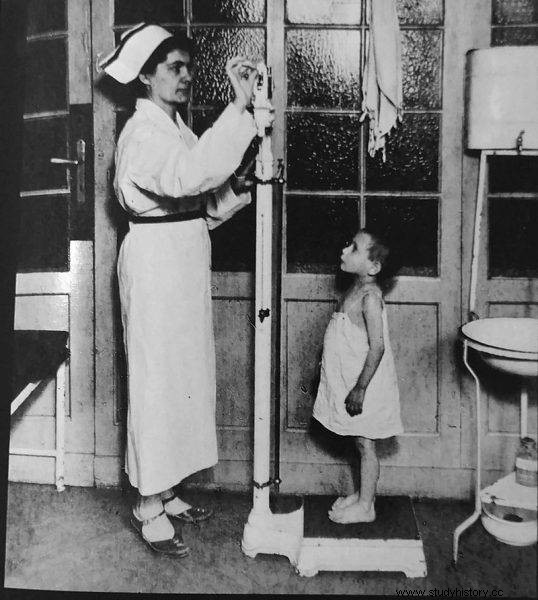
Despite the ongoing occupation and the campaign against the Jews, Korczak and his associates fought for funds to support the children.
Despite the ongoing occupation and the campaign against the Jews, fought for funds to support the children . He tried to ensure normality for his charges in these tragic conditions, which he immortalized in the Diary written in the ghetto. . He was also involved in work for other institutions - incl. The Main House of Refuge on Dzielna Street (the largest orphanage in the Jewish district of Warsaw). He had several offers from friends to help him escape from the ghetto and arranging a hideout for him on the Aryan side. He did not want to leave the children - just like the rest of the employees of the Orphans' Home.
Korczak's Last March
On July 22, 1942, the Germans began the so-called The Great Action - liquidation of the Warsaw ghetto. Most likely on August 5, the residents of the Orphans' Home - Janusz Korczak , his associates (including Stefania Wilczyńska, Natalia Poz, Róża Lipiec-Jakubowska) and 200 children were taken to the Umschlagplatz and sent to the extermination camp in Treblinka.
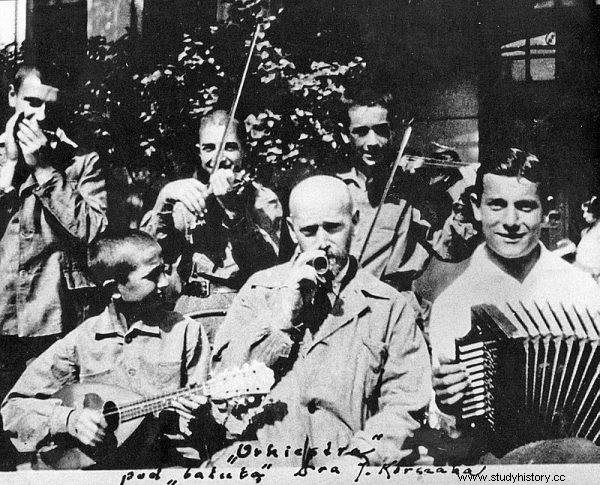
Korczak with a children's "orchestra" at the Orphans' Home
The last path of Korczak and his pupils has become legendary. Father Jan Twardowski, during a mass in the Church of the Visitation Sisters in Warsaw on December 29, 1971, described:“He held the hands of the children until the end, he died with them. He passed away in a threadbare uniform of a Polish military doctor, which he put on on the first day of the Germans' entry into Warsaw and wore it ostentatiously until his death. " Władysław Szpilman recalled the last march:
I think on August 5 (...) accidentally I witnessed the departure of Janusz Korczak and his orphans from the ghetto (...). He had spent many years of his life with them and now, on their last journey, he did not want to leave them alone. He wanted to make it easier for them. He explained to the orphans that they had reason to be happy because they were going to the countryside (...). When I met them on Gęsia, the children were singing in chorus, beaming, as they were walking, a little musician was playing for them, and Korczak was carrying the two youngest, also smiling ones, in his arms and telling them something funny.
Irena Sendler commented:"(...) he was walking upright, with a face resembling a mask, seemingly composed (...). The youngest child was held in his arm and the other was carried by the handle. In the memories of different people it is like this and in others it is different, which does not mean that someone is wrong. (...) the way from the Orphans' Home to Umschlagplatz was long. It lasted four hours. ”
Epitaph
Janusz Korczak and his children probably died later on the same or the next day in Treblinka. However, since the exact date of the Old Doctor's death is unknown, in 1954 the District Court in Lublin determined it to be May 9, 1946. The ruling was later changed. It is now assumed that he died on August 7, 1942. To this day, however, in schools, kindergartens and educational institutions, his words resound:"There are no children, there are people".
